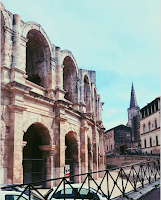Karina Rodriguez
Reattu Museum - Arles, France
 |
| This was just a small portion of where the Pope lived while staying in Avignon, France. |
For the past two weeks I have been in France playing soccer with the U20 U.S. Women's National Team. On the off days when we are not playing soccer we have been given the opportunity to see two of the cities around where I am staying. The main city closest to me is the city of Avignon. Here the Pope came to stay for a bit years ago and many of the buildings are older but very very cool to see as we do not really have anything like it in the U.S. We walked around the town and enjoyed the life of the people in Avignon.
 |
| Our coordinator bought us this ticket that allowed us entry into multiple sight seeing locations. |
Another city that they allowed us to walk around and sight see was Arles, France. Although Avignon was very beautiful and unique in its own way, I enjoyed Arles much more. There were so many cool things to see. We were given an hour and a half to see the city and walk around where we pleased before we had to meet up again for a team dinner. We were given a ticket that allowed us to visit a few different buildings and locations in the city. First we stopped to see the amphitheater as it is nothing like anything that we have in the U.S. and only something you see in Europe. There we were also able to go up a high staircase that took us to a lookout spot over the whole city. The city view was breathtaking. We then stopped for gelato because who can resist gelato in Europe, I went for the classic chocolate and combined it with a scoop of coffee. Our final stop took us to the Reattu Museum where my friends and I viewed paintings from Pablo Picasso.
 |
| This photos was taken in front of one of Pablo Picasso's paintings in the Reattu Museum we visited in Arles, France. |
It was a small museum as all the regular buildings are quite small as well but they had some pretty cool paintings from Pablo Picasso. The paintings are mostly of faces and the faces are very abstract. This reminded me very much of Neuroscience and Art from Week 7. Although Pablo Picasso may not have been under the influence of LSD or anything like that many of his paintings look as though he was. His brain reaches creative places that not many can do on their own. We can only assume that his behaviors and personalities had an impact on his artwork as the brain ties together many different aspects of a person. Pablo Picasso's art also resembles Mathematics and Art from Week 2. We see the simplicity of mathematics in the portraits he created. The portraits are composed of different shapes and lines of all kinds, none crossing but all connecting to form the end product.
 |
| Arles Amphitheater |
Works Cited
Arles Amphitheater https://www.atlasobscura.com/places/arles-amphitheatre
Avignon http://www.avignon-et-provence.com/en/tourism-provence/avignon
Museum Reattu http://www.museereattu.arles.fr
Picasso in Museum Reattu http://www.museereattu.arles.fr/pablo-picasso.html
Vincent Van Gogh in Arles http://www.vangoghroute.com/france/arles/


